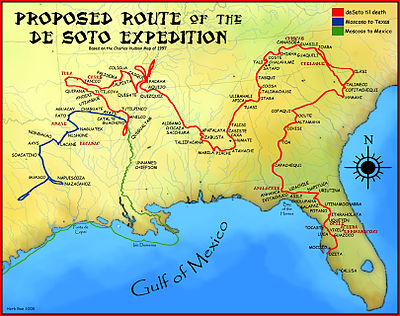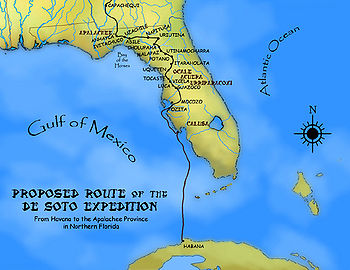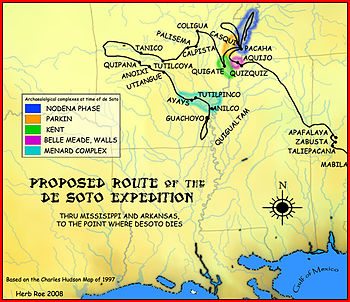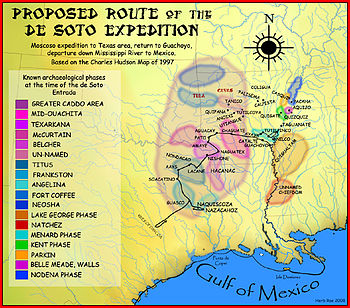
This is a list of sites and peoples visited by the Hernando de Soto Expedition in the years 1539–1543. In May 1539, de Soto left Havana, Cuba, with nine ships, over 620 men and 220 surviving horses and landed at Charlotte Harbor, Florida. This began his three-year odyssey through the Southeastern North American continent, from which de Soto and a large portion of his men would not return.
They met many varied Native American groups, most of them bands and chiefdoms related to the widespread Mississippian culture. Only a few of these ancestral cultures survived into the seventeenth century, or their descendants combined as historic tribes known to later Europeans. Others have been recorded only in the written historical accounts of de Soto's expedition.
Florida

- Uzita
- Mocoso
- Urriparacoxi
- Timucua
- Ocale
- Acuera
- Potano
- Alachua culture
- Northern Utina
- Yustaga
- Uzachile
- Anhaica
- Apalachee
- Narváez expedition's "Bay of Horses"
Georgia

The peoples the expedition encountered in Georgia were speakers of Muskogean languages. The expedition made two journeys through Georgia - the first heading northeast to Cofitachequi in South Carolina, and the second heading southwest from Tennessee, at which point they visited the Coosa chiefdom.
First Leg
After leaving Ocute, the expedition crossed the "Wilderness of Ocute" (the modern-day Savannah River basin) to arrive in present-day South Carolina. Artifacts from the first leg have been found in Telfair County, Georgia.
Second Leg
All territory the expedition crossed through during this leg was under the control of Coosa, a paramount chiefdom with territory in Georgia, Alabama, and Tennessee.
- Coosa chiefdom
- Little Egypt, the likely site of the Coosa capital
- Sixtoe Mound
- Bell Field Mound Site
- Talimachusi
- Etowah Indian Mounds (Itaba)
South Carolina
The primary destination of the expedition in South Carolina was the paramount chiefdom of Cofitachequi. The people of this chiefdom were likely the ancestors of the modern Cherokee and Catawba.
- Hymahi
- Cofitachequi, likely located at the present Mulberry Plantation
- Talimeco
North Carolina
Tennessee

Alabama
Parts of Coosa extended into Alabama. The other primary chiefdom encountered by the expedition was that of Tuscaluza. The peoples encountered in Alabama were likely the ancestors of the modern Creek, Alabama, and Choctaw.
Mississippi

Arkansas
- Aquixo
- Casqui, believed by many archaeologists to be the same as the site of the Parkin Archeological State Park.
- Pacaha, believed by many archaeologists to be the Nodena site.
- Chaguate
- Coligua
- Tunica people
- Tula people
- Anilco, possibly the Menard complex in the southeastern corner of the state.
- Guachoya
- Quapaw
- Caddoans
Texas

All the peoples which the expedition encountered in Texas were the ancestors of the modern Caddo, especially the Hasinai and Kadohadacho confederacies. Intentionally misled by their Caddo guides, the expedition wandered around Texas while only encountering a few major Caddo centers, though there were many that lay not far beyond where they traveled. Eventually they were forced to turn around after reaching the River of Daycao, variously identified as the Brazos, Trinity, or even the Colorado. Beyond Daycao, the chroniclers of the expedition claimed that people did not grow maize and subsisted off the land as hunter-gatherers.
As this leg of the expedition took place after the death of both de Soto and Juan Ortiz, his primary translator, the records are more sparse and reveal less information than in earlier parts of the journey.
- Caddo
- Nadaco (Nondacao)
- Hasinai
- Soacatino
- Adai (Native American culture)
See also
- Alabama language
- Caddoan languages
- Cherokee language
- Chickasaw language
- Choctaw language
- Creek language
- Etowah Indian Mounds
- Hitchiti
- Lake Jackson Mounds Archaeological State Park
- Lake Village, Arkansas
- Mississippian culture
- Moundville Archaeological Site
- Ocmulgee National Monument
- Pisgah phase
- Southeastern Ceremonial Complex
- Timucua language
- Yamasee
- Yazoo tribe
References
- ^ Hudson, Charles M. (1997). Knights of Spain, Warriors of the Sun. University of Georgia Press. ISBN 9780820318882.
- ^ Morse, Phyllis A. (1981). Parkin. Arkansas Archaeological Survey. OCLC 7540091.
- Barr, Juliana (2017). "There's No Such Thing as "Prehistory": What the Longue Durée of Caddo and Pueblo History Tells Us about Colonial America". The William and Mary Quarterly. 74 (2): 203–240. doi:10.5309/willmaryquar.74.2.0203. ISSN 1933-7698. S2CID 151938572.
- Carter, Cecile Elkins (1995). Caddo Indians: Where We Come From. University of Oklahoma Press. ISBN 9780806127477.
- Bruseth, James E.; Kenmotsu, Nancy A. (January 1, 1994). "From Naguatex to the River Daycao: The Route of the Hernando de Soto Expedition through Texas". North American Archaeologist. 14 (3): 199–225. doi:10.2190/JBKW-6G2Q-T4LY-LT6V. ISSN 0197-6931. S2CID 162079440.
- Native American populated places
- Native American-related lists
- Colonial United States (Spanish)
- Expeditions from Spain
- 1540s in New Spain
- 1540s in North America
- Spanish exploration in the Age of Discovery
- Late Mississippian culture
- Mississippian culture
- Native American history of Alabama
- Native American history of Arkansas
- Native American history of Florida
- Native American history of Georgia (U.S. state)
- Native American history of Mississippi
- Native American history of North Carolina
- Native American history of South Carolina
- Native American history of Tennessee
- Native American history of Texas
- Colonial Louisiana
- Spanish Florida
- Spanish Texas
- Archaeology of the United States
- Eastern United States
- Southeastern United States
- Spanish colonization of the Americas
- 16th century in North America
- Tennessee history-related lists
- Texas history-related lists
- North Carolina history-related lists
- Georgia (U.S. state) history-related lists
- Alabama history-related lists
- Florida history-related lists
- Arkansas history-related lists
- Mississippi history-related lists
- South Carolina history-related lists